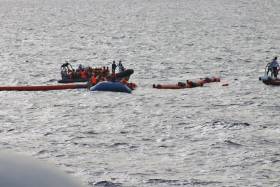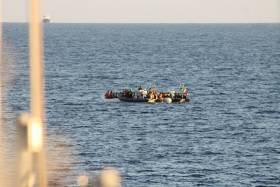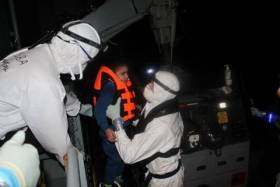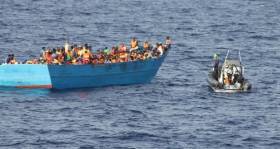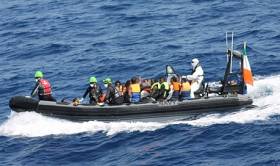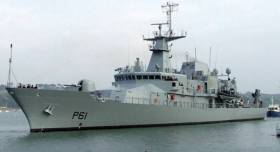Displaying items by tag: LE Samuel Beckett
Naval Service Vessel Rescues More Migrants In Mediterranean
#Navy - The Naval Service’s LÉ Samuel Beckett assisted in rescuing 140 migrants from the Mediterranean off Libya this morning (Saturday 3 December), as The Irish Times reports.
Food, water and medical treatment were provided to the people who were transferred from their rubber boat to the rescue vessel MS Aquarius as part of the latest humanitarian operation in the region.
The operation comes just five days after the crew rescued more than 500 migrants from just four rubber vessels off Tripoli, as previously reported on Afloat.ie.
LE Samuel Beckett Rescues More than 500 Migrants
#MigrantsRescue - LÉ Samuel Beckett located and rescued a total of 508* migrants from four separate rubber vessels in the early hours of yesterday morning.
The search and rescue operation according to the Naval Service took place 50 nautical miles NW off Tripoli, Libya and was at the request of the Italian Maritime Co-Ordination Centre.
The first rescue operation began at 02.20am and all migrants were taken on board LÉ Samuel Beckett by 12.20pm. The 508* migrants received food, water and medical treatment where required.
This brings to 2,818* migrants rescued by the LÉ Samuel Beckett since it deployed to the area of operations on 23rd September of this year.
LÉ Samuel Beckett will now bring all rescued persons to a designated Port of Safety.
*Figures for the operation are provisional until confirmed by the Italian authorities.
Search And Rescue of Almost 100 Migrant Refugees Tasked to LÉ Samuel Beckett
#MigrantRescues – Two search and rescue missions (SAR) tasked by LÉ Samuel Beckett last week saved almost 100 migrant refugees off the Libyan coast.
According to the Naval Service the most recent SAR took place on Friday night following a request from the Italian Maritime Rescue Co-Ordination Centre. LÉ Samuel Beckett located and rescued a total of 50* migrants from a rubber 25 nautical miles north-west of Tripoli. The rescue operation began at 8.05pm and all migrants were taken on board LÉ Samuel Beckett by 10.20pm. The rescued persons were transferred to the NGO vessel Bourbon Argos.
Three days previously on the Tuesday, LÉ Samuel Beckett was also deployed by the Italian authorities to locate a total of 40* migrants. Again this incident involved a rubber vessel during a the rescue operation that was conducted 44 nautical miles north east off the Libyan capital. The operation began at 11am and all migrants were taken on board the OPV90 class vessel by 1.30pm. The 40 rescued persons were transferred to another NGO vessel, the Aquarius.
This brings to 2,310* migrants rescued by the LÉ Samuel Beckett since it deployed to the Mediterranean area of operations on 23 September of this year.
*Figures released on the days for both SAR operations are provisional until confirmed by the Italian authorities.
#BusyBeckett - In the space of two days, LÉ Samuel Beckett has carried out three separate rescue operations involving more than 400 people in the Mediterranean off north Africa.
The first incident took place yesterday, almost 40 nautical miles off the Libyan capital, Tripoli, following a request from the Italian Maritime Rescue Co-Ordination Centre. This is where the Irish Naval Service OPV90 class vessel located and rescued a total of 299* migrants from three separate rubber vessels during search and rescue (SAR) operations.
The first rescue operation began at 08.50am and all migrants were taken on board LÉ Samuel Beckett by 12.15pm. The migrants received food, water and medical treatment where required.
On the previous day, Wednesday, LÉ Samuel Beckett carried out another SAR which saw 122* migrants from a rubber vessel again in the same area north east of Tripoli. The rescue operation began at 8.00am and all migrants were taken on board LÉ Samuel Beckett by 12.30pm. Likewise migrants recieved assistance including medical treatment where required.
LÉ Samuel Beckett transferred all rescued persons to the VOS Hestia. This vessel transported them to a port of safety and from there they were administered by Italian authorities.
*Figures for both SAR operations are provisional until confirmed by the Italian authorities.
More Than 700 Migrants Rescued by LÉ Samuel Beckett off Libya
#MigrantsRescued - A total 772 migrants were rescued by LÉ Samuel Beckett from a large wooden barge during a “complex search and rescue operation” off the coast of Tripoli, Libya.
The operation writes The Irish Times was carried out on Friday following a call for assistance from the Italian Maritime Rescue Co-Ordination Centre.
The Irish Naval Service vessel located and rescued the migrants from the barge about 36 nautical miles (67km) northeast of the Libyan capital.
Afloat adds that it is a month ago since the OPV90 leadship departed Cork Harbour on the deployment to provide humanitarian duties.
Recently Deployed LÉ Samuel Beckett Rescues Migrants
#MigrantRescue - The Naval Service recently deployed LÉ Samuel Beckett, located and rescued a total of 130*migrants yesterday during a search and rescue (SAR) operation. The rescue took place 22 nautical miles NE of Tripoli, Libya.
The rescue operation arose from a request from the Italian Maritime Rescue Co-Ordination Centre when at 11am the migrants were brought on board LÉ Samuel Beckett, where they received food, water and medical treatment where required.
LÉ Samuel Beckett is currently awaiting further tasks. So far the OPV90 class has rescued 780 people since switching humanitarian task to the Mediterranean from sister, LÉ James Joyce which was welcomed home to the Naval Base, Cork Harbour at the end of last month.
*Figures for the SAR operation are provisional until confirmed by the Italian authorities.
Record Rescued in Number of Migrants by LÉ Samuel Beckett
#RecordRescue - Records were broken by LÉ Samuel Beckett last night with the biggest migrant total transported to safety in one single day, writes The Irish Examiner.
The Naval Service patrol ship was steaming towards an Italian port with 652 rescued men, women, and children.
People-smugglers took advantage of good weather conditions in the Mediterranean Sea yesterday as they herded people on board flimsy dinghies.
They set them afloat in the knowledge that they would either drown on the crossing from Libya to southern Europe, or be rescued by military boats or vessels run by volunteer organisations such as Médecins Sans Frontières. For more on the record migrant rescued, click here.
L.É. Samuel Beckett Returns to Mediterranean Rescue Role
#BeckettReturns - L.É. Samuel Beckett departed Cork Harbour for the Mediterranean this morning, writes the Evening Echo, as the Naval Service continues its role in European search and rescue operations in the region.
The OPV90 class patrol vessel departed from Haulbowline Naval Base at 10am, and is set to return in mid-December, taking over from L.É. James Joyce which returns home next Friday, September 30, following three months at sea.
The LÉ James Joyce successfully located and rescued a total of 531 people over a recent weekend in two operations conducted with the Italian Coastguard North West of Tripoli.
The crew most recently rescued 265 people in a humanitarian operation off Libyan coast last week. Tragically attempts to resuscitate some of those found failed, with one man and four women, one of whom was heavily pregnant, declared dead by a Red Cross doctor.
'Beckett' Rescues More Refugees from Inflatable Raft off Libya
#InflatableRaft - Following an intense spate of rescuing refugees last week, LÉ Samuel Beckett carried out its latest mission in the Mediterranean yesterday when 111 people were found in an inflatable raft off Libya.
At 05:39 am Irish time the LÉ Samuel Beckett began a search and rescue (SAR) operation 32 nautical miles off the north African coast following a task assigned to the OPV by the Italian Marine Rescue Co-ordination Centre (IMRCC) to investigate an inflatable rubber craft.
At the scene, the LÉ Samuel Beckett took on board 111 people (107 males and 4 females)*. The SAR was completed at 08.34am. All people embarked are receiving food, water and medical attention where required.
Figures for yesterday's operation are provisional until they are confirmed by the Italian authorities.
Since the LÉ Samuel Beckett was deployed to the Mediterranean in late September for 'Operations Pontus', the OPV has rescued a total 977 people (not including yesterday's SAR mission).
The leadship of the OPV90 / Beckett class is third Irish Naval Service vessel to deploy to the area of operations. The OPV has a crew of 59 personnel, including an Army and Air Corps medic and is commanded by Lieutenant Commander Anthony Geraghty.
Refugees Rescued Over Three Days by LE Samuel Beckett off Libya
#BeckettRescues- Following yesterday's rescue by LÉ Samuel Beckett and in the transfer off 99 people to MSF Dignity 1 off Tripoli, Libra, the OPV was involved today in further humanitarian missions in the Mediterranean Sea.
This brings to a total of three consecutive days that the Naval Service has successfully carried out search and rescue (SAR) operations off the failed North Africa state.
At 4.10 am Irish time today, the LÉ Samuel Beckett located an un-seaworthy craft carrying 108* people 60 kilometres east north east of Tripoli. The LÉ Samuel Beckett was appointed on scene coordinator and using their rigid hull inflatable boats (rhibs) transferred the 108 people to the MV Bourbon Argos.
Upon completion at 7.20 am the LÉ Samuel Beckett located another vessel brought 119* persons on board from a rubber craft.
On Wednesday, at 8.15 am Irish time, the LE Samuel Beckett was appointed on scene coordinator for SAR operations 87 kilometres east north east of Tripoli, Libya.
On this first SAR of the three days of operations, the OPV with assistance from the Italian ITN Aliseo and its helicopter assets directed the Medicins Sans Frontiére (MSF) vessel MV Dignity 1 which embarked 100 people, 27 of whom are women, 3 of whom are pregnant.
The LÉ Samuel Beckett is awaiting further direction for the Italian Marine Rescue Coordination Centre (MRCC.)
*Figures for today's operation are provisional until confirmed by the Italian authorities.
So far the LÉ Samuel Beckett has directly rescued 661 people since it's deployment, excluding today's figures.
Previous to the LÉ Samuel Beckett's deployment to the Mediterranean with OPERATION PONTUS, the LÉ Eithne & LÉ Niamh rescued 7,397 people.

